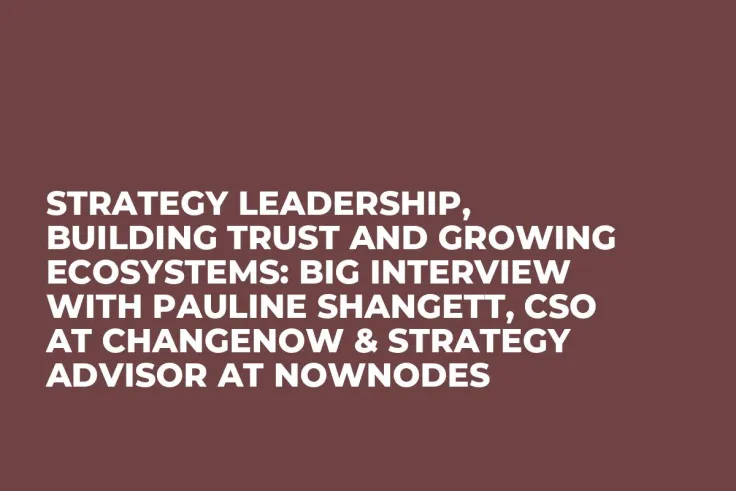
Disclaimer: The opinions expressed by our writers are their own and do not represent the views of U.Today. The financial and market information provided on U.Today is intended for informational purposes only. U.Today is not liable for any financial losses incurred while trading cryptocurrencies. Conduct your own research by contacting financial experts before making any investment decisions. We believe that all content is accurate as of the date of publication, but certain offers mentioned may no longer be available.
In Web3, building a solid brand, community and trust in general might be challenging, in particular in the long run and amid changing market circumstances. Pauline Shangett is a Web3 veteran and chief strategy officer of ChangeNOW, one of the largest instant exchanges in crypto.
In our exclusive interview, Pauline covered her vision of current market developments, shared the secrets of creating growth strategies in Web3 and blockchain, and introduced what is next for her products.
U.Today: Hey, Pauline, thanks for coming! Please introduce yourself. Prior to joining the ChangeNOW ecosystem, what was your career path?
Pauline Shangett: I’m Pauline Shangett, Chief Strategy Officer at ChangeNOW, a crypto exchange platform that processes over a billion dollars in monthly volume. I joined the industry back in 2018, originally stepping in as CMO.
In just six months, we doubled both our user base and trading activity, it was a wild ride and gave me a front-row seat to how fast this space can scale when you get things right. Over the years, I’ve moved from just marketing into more of a big-picture strategy role, because what really gets me excited is building growth that lasts. I’m not in it for the hype cycles, I want to create systems and ecosystems that actually stand the test of time.
If I had to name my superpower, it’d be mixing deep blockchain knowledge with a practical, revenue-focused approach. And I try to keep everything I do flexible, transparent, and aligned with ChangeNOW’s long-term vision.
U.T.: First off, you were pretty well known in the industry as a star CMO. Let’s talk about this stage of your growth. What makes blockchain marketing different?
P.S.: The biggest difference is that in blockchain, you can’t fake it. In traditional marketing, you can create a perception and ride it for a long time before the product has to fully catch up. In crypto, the blockchain fact-checks you in real time. If your swaps are slow, if your rates are off, if your platform isn’t reliable, well...everyone sees it, and they’ll talk about it instantly. That creates a completely different kind of accountability.
The second thing is community. In Web2, your community is basically your user base. In Web3, your community is part of your governance, your distribution, and sometimes even your development. They’re not just customers; they’re real stakeholders. And that changes how you think about marketing. It’s less about just broadcasting a message and more about having a two-way conversation, where people actually feel invested in the product itself.
And finally, there’s the element of risk communication. In crypto, you’re not only talking about features and benefits, you’re also addressing volatility, regulatory uncertainty, and security risks. Your brand strength is often measured not by how hyped you are during bull markets, but by how transparent and steady you are during downturns or incidents. To me, that’s the art of crypto marketing: balancing education, transparency, and inspiration all at once.
U.T.: What would be your recommendation to young Web3/blockchain marketers?
P.S.: Honestly, my number one advice? Stay curious. Like, really curious. This space moves so fast, if you’re not picking up something new every day, you’ll fall behind before you even notice. The more you get the tech, the better your marketing gut will be.
Second, learn to read on-chain data. It’s the most honest signal you can get. You’ll understand user behavior, where people are dropping off, which assets are trending, and where liquidity is flowing. Social media hype is loud, but on-chain data is the real story.
And third, be authentic. Communities here are sharper than in any other industry. If you try to oversell, people will totally see right through it. But if you’re honest, open, and genuinely care about what you’re building, folks will respect you, even when things aren’t perfect.
U.T.: Let’s move forward. How does your CMO background help you in building strategy for a $1 billion/month ecosystem?
P.S.: Marketing gave me what I’d call a “market radar.” It trained me to listen carefully, spot weak signals, and anticipate shifts before they fully form. When you’re running an ecosystem that moves a billion dollars a month, these small signals matter. A slight change in user behavior or sentiment can cascade into major impacts.
My background as a CMO also taught me the value of rapid experimentation. In marketing, you’re constantly launching campaigns, testing, iterating, doubling down on what works and killing what doesn’t. I’ve carried that mindset into strategy. Instead of campaigns, I’m now experimenting with product directions, liquidity partnerships, ecosystem initiatives. The principle is the same: set up feedback loops, measure, and adapt fast.
And most importantly, marketing made me obsessed with the user. At the end of the day, strategy only works if it resonates with people who actually touch your product. That user-first instinct helps me make sure our big-picture decisions never drift too far from what people actually need.
U.T.: Chief Strategy Officer is not among the most common roles for crypto. Could you please share what this means for you?
P.S.: For me, being CSO means connecting the dots between the short-term and the long-term. In crypto, it’s so easy to get swept up in hype cycles or distracted by the crisis of the week. My job is to make sure the company is not just surviving day to day but building momentum that compounds over years.
That means designing for resilience. A lot of people think of “strategy” as a PowerPoint deck, a vision statement, or a roadmap. I see it more as building systems that can withstand volatility. It’s about asking: what partnerships keep us flexible? What tech investments make us future-proof? How do we structure our ecosystem so we’re not dependent on any single trend or market condition? Strategy in crypto is less about predicting the future and more about making sure you’re ready for whatever the future throws at you.
U.T.: Let’s discuss the product. ChangeNOW has been one of the instant swaps segment leaders for a very long time. What is the secret sauce?
P.S.: The secret sauce is simplicity backed by reliability. From the very beginning, we’ve been obsessed with making swaps quick, easy, and non-custodial, no hoops to jump through, no hidden catches. But the reason it feels simple is because under the hood it’s incredibly complex.
We’ve built smart routing that doesn’t just look for the best price on paper but calculates the actual end result after fees, slippage, and network conditions. We have fallback mechanisms so if one route fails, the transaction automatically re-routes instead of dying. We have compliance processes that let us remain open and accessible while still being predictable and safe.
Users see “it just works.” What they don’t see are the years of engineering, infrastructure, and trust systems behind that simplicity. And that’s how it should be: the complexity stays on our side, and the simplicity stays on theirs.
U.T.: What is your forecast on the next stage of growth for the CEXes sphere?
P.S.: I think CEXes are going to evolve into hybrids. The demand for liquidity and speed isn’t going anywhere, but the expectation for transparency and self-custody is only growing. So we’ll see more exchanges offering non-custodial options, integrating wallets directly, and moving toward models where they act more like liquidity routers than custodians.
Proof-of-reserves will mature from occasional snapshots to real-time cryptographic proofs, and regulators will push the space toward more regional hubs with different levels of compliance and access. At the same time, DEX infrastructure is improving fast when it comes to user experience, so the line between centralized and decentralized is starting to blur. The exchanges that will really succeed are the ones that lean into that blur instead of fighting it.
U.T.: While you are building a strategy for ChangeNOW, what are the main inputs, catalysts and points to consider?
P.S.: When I build strategy, I always balance three things: market signals, user behavior, and technology shifts. On the market side, we’re constantly watching adoption curves, regulatory frameworks, and institutional movements. On the user side, we study how people actually move assets, where they get stuck, what chains they prefer, what frustrates them. On the tech side, we’re tracking everything from L2 adoption to account abstraction to new liquidity protocols.
The real art is connecting those layers. It’s not enough to know that users want cheaper fees, or that a new rollup just launched, or that regulators are tightening in one region. You have to bring it all together into a coherent picture and act on it before it becomes obvious to everyone else. That’s the job.
U.T.: Let’s talk a little bit about the ecosystem. Regarding the NOW family, we can’t overlook NOWNodes. What’s next for the project, and how does it adapt to changing markets?
P.S.: NOWNodes has grown into one of the most reliable blockchain API providers, supporting wallets, explorers, and dApps all around the world. The next phase is all about scale and adaptability. Developers are building in new ecosystems every day, from DeFi protocols to blockchain games to enterprise solutions, and NOWNodes needs to be the infrastructure they can always count on.
That means keeping up with the rollup-centric future by supporting new L2s, ensuring access to archival data, and guaranteeing performance that’s not just fast but predictable. In crypto, infrastructure is like electricity; if it works, no one notices, but if it goes down, everything stops. Our job with NOWNodes is to make sure developers never have to think twice about whether their backend is going to hold up.
U.T.: What position do you hold within the NOWNodes structure?
P.S.: Within NOWNodes, I serve as the strategic anchor, not just for guiding its evolution but for ensuring it stays connected to the broader ChangeNOW ecosystem. NOWNodes began as a spin-off from our work at ChangeNOW back in 2019, initially offering quick access to blockchain nodes via API. Over the next several years, it’s grown into a trusted BaaS (Blockchain-as-a-Service) provider, supporting over 110 networks with enterprise-grade reliability. In my role, I oversee how NOWNodes scales, how it integrates with emerging technologies, and how we build it to be not just resilient today, but future-proof for what’s next.
U.T.: Which partners is NOWNodes currently working with? Can you highlight some real examples?
P.S.: Absolutely! NOWNodes has really earned trust across the industry, and the ecosystem just keeps growing. Our clients include big names like Trust Wallet, Avalanche, Tangem, Crypto.com, Exodus, and so on. More and more teams are using NOWNodes because it just works, no fuss, no surprises.
U.T.: That brings up a natural question: a lot of people in Web3 still argue whether the key to sustainable governance is about running your own hardware or going full cloud. What’s your take?
P.S.: I honestly don’t think the answer lies in either of those extremes. I believe it’s not about hardware, and it’s not about cloud. It’s about resilience. You can stack servers in your basement or rent unlimited virtual machines, but that alone won’t carry Web3 forward. Real sustainability comes from how the infrastructure is built and how it adapts. To me, resilience means having smart, distributed backups so nothing depends on a single point of failure, it means fast, human-centric support when developers need it most, it means transparent, scalable pricing, and it definitely means full multichain support. Infrastructure should be something you can grow with, not something you eventually grow out of. And that kind of resilience isn’t rented or outsourced; it’s designed, built, and constantly reinforced.
U.T.: One last general question I can’t skip: what will be the next narratives in crypto, and how will ChangeNOW adapt?
P.S.: I see three big narratives on the horizon. The first is scalability. We’re finally at a point where rollups and modular architectures are making crypto usable at scale, and that opens the door to mainstream adoption. The second is real-world assets. Tokenizing real-world value isn’t just a concept anymore, it’s happening, and it’s going to reshape both finance and blockchain ecosystems. The third is privacy. As crypto goes mainstream, people are going to realize that freedom and data protection aren’t luxuries, they’re necessities.
At ChangeNOW, we adapt by staying flexible while keeping our core promise intact. No matter what the next trend or story is, people will still need a simple, safe, non-custodial way to move value. That’s our role in the ecosystem to be the bridge that just works, no matter how things change.
U.T.: Thank you so much for coming!
 Denys Serhiichuk
Denys Serhiichuk Tomiwabold Olajide
Tomiwabold Olajide Alex Dovbnya
Alex Dovbnya Gamza Khanzadaev
Gamza Khanzadaev Godfrey Benjamin
Godfrey Benjamin